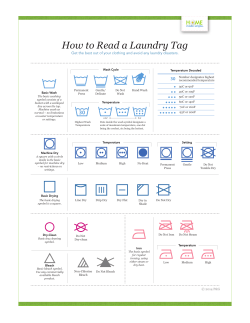
WHAT IS A MAUCHA DIAGRAM?
Maucha diagram SilberbauerM@dwaf.gov.za WHAT IS A MAUCHA DIAGRAM? Reszo Maucha developed this symbol in the 1920s and 1930s in order to summarise the major ions in water in a way that would allow rapid comparison between two water samples (Maucha, 1932). Using simple but tedious trigonometry, he designed an eight-pointed star symbol where the anionic concentrations are on the left and the cations are on the right. Concentrations are converted to milliequivalents per litre, so that the balance of cation and anion charge can be seen at a glance. The background circle shows the shape of a theoretical, perfectly balanced sample with each ion at the same concentration. A 1960s modification to the symbol scales the whole star in proportion to the total dissolved salts (Broch and Yake, 1969). A log scale is used where the data set consists of samples with widely differing salinities (Silberbauer and King, 1991). Here is the anatomy of a Maucha ionic diagram: DOES IONIC COMPOSITION CHANGE WITH TIME? The Maucha diagram is a convenient way to symbolise TDS on a map while simultaneously giving an indication of salt ratios. Does a Maucha symbol generated from a single water sample paint the whole picture? Plots of flow and ionic composition against time suggest that the ionic composition is fairly stable under normal conditions. Floods, droughts and severe pollution incidents may affect salinity and salt ratios, and a single Maucha diagram could be misleading under these circumstances. The ideal is to look at both pictures, spatial and temporal. If this is not possible, then the spatial symbols should be integrated over a period of time using mean or median concentrations. (Note that in the graph below, the flow axis for 1990 is 0-20 m3/s and for 1991 0-130 m3/s.) WHAT DOES THE MAUCHA DIAGRAM TELL US? Above right are Maucha diagrams for two water samples, one taken at the upper end of the Vaal River catchment and the other at the lower end. Note that the first symbol is smaller than the second, and that it has a relatively higher total alkalinity (the light blue HCO3- spike... it is difficult to split total alkalinity into HCO3- and CO3 reliably in a preserved sample, so all alkalinity is represented here as HCO3-). The proportions of sulphate (dark blue) chloride (green) and sodium (yellow) are much greater in the second sample. This reflects the way in which Vaal River water starts off in a "natural" calcium carbonate state and picks up sulphate from mining activities and sodium chloride from urban waste in Gauteng, until one has the very "unnatural" ionic composition shown on the right. The chloride and sulphate increase the sample's corrosion index. Michael Silberbauer REFERENCES Maucha, R (1932) Hydrochemische Metoden in der Limnologie. Binnengewasser 12, 173pp. Broch, E S & Yake, W (1969) A modification of Maucha's ionic diagram to include ionic concentrations. Limnology and Oceanography 14, 933-935. Silberbauer, M J & King, J M (1991) Geographical trends in the water chemistry of wetlands in the south-western Cape Province, South Africa. Southern African Journal of Aquatic Sciences 17 (1/2) 82 - 88. Page 1 4/6/2006
© Copyright 2025





















